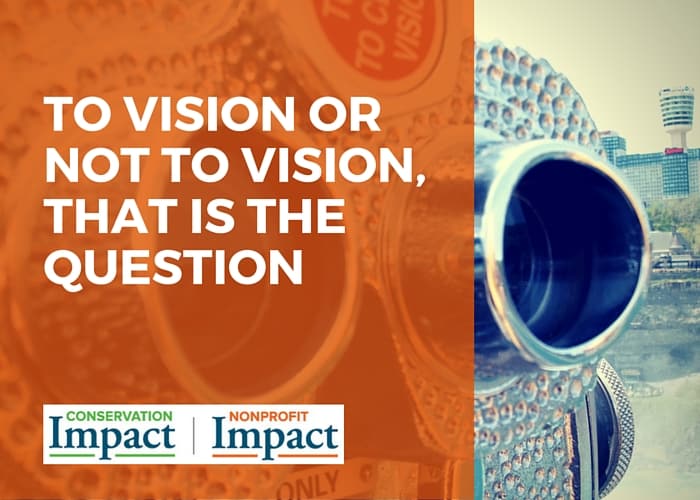
To Vision or Not to Vision
To vision or not to vision. That is the question.
Recently, a friend who works for a large nonprofit shared his plans to take the staff through a visioning process. He had carefully reviewed the organizational development literature and was excited to use the approach he had selected.
Staff and board can become connected to shared values and a clear vision of success from such a process. For a mission-driven organization, a clear, compelling vision is an invaluable tool. Indeed, every planning process ultimately relies upon an organization’s vision.
Vision doesn’t fix everything
Unfortunately, I couldn’t wholeheartedly share my friend’s excitement. Now, there’s nothing wrong with a visioning process. It’s neither good, nor bad. But it also wasn’t an appropriate fit for the situation. In his enthusiasm to have his staff feel more connected, I worried my friend hadn’t done the kind of analysis needed to make sure the process was the right one for his organization.
There’s a reason why all of our projects start with an analysis. An objective, substantive organizational analysis illuminates underlying issues and defines the root causes of those issues. And that’s the information an organization’s leaders need in order to decide what kind of process – visioning, strategic decision making, business planning, etc. – is the right one to achieve their desired results.
For example, imagine an organizational analysis uncovered these underlying issues:
- A lack of clear, simple policies and inconsistent enforcement of those policies that were in place
- Board and staff members circumvent the chain of command and make decisions at inappropriate levels
- Staff are treated inequitably by management (e.g., based on position, gender, or personal relationships)
- Staff and board have few clear performance expectations
- The functions of leadership and management are not carried out
At first glance, a visioning process – which can foster a deep sense of connection to the organization and its mission – might be just the ticket.
But for a moment, put yourself in the shoes of a staff member at this organization. Policies are unclear, you don’t know whether or not you’re doing a good job. People seem to be treated differently depending upon who they are friends with. Your leaders and managers have been letting this situation persist for some time. Does talking about a shared vision for the future seem likely to help fix the problems that affect your workplace?
In this example, not only is visioning going to be ineffective. Neglecting to explicitly address these underlying issues could be truly detrimental.
How do you know if a visioning process is right for you?
Answer these three questions:
- What problem are you trying to solve?
- What results do you need from the visioning process? More specifically, what do you want the staff, board, or organization to do differently?
- Most importantly, after the process is complete, what will it take for the organization to behave in integrity with the vision (i.e., what alignments to strategies, processes, practices, systems, etc. will be needed)?
Assess the readiness of your organization to engage in the process with sincerity and commitment. If you undertake visioning, be ready to address the resulting implications to ensure that the organization can truly operate in alignment with that vision. A visioning process without alignment isn’t useful; in fact, it’s potentially dangerous.

